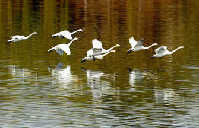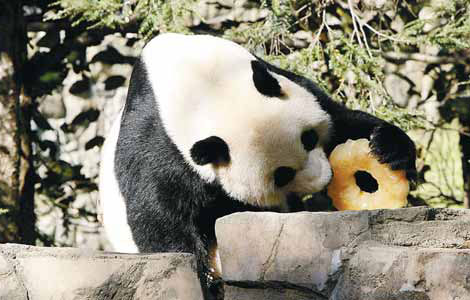Royal care for swans
Updated: 2013-12-05 07:14
By Zhao Yinan (China Daily)
|
||||||||
 |
|
Cranes make a stopover at the reserve during their annual migration. |
"That number represents half of all the new oriental white storks hatched in China this year," Shan says.
What is more amazing is that more of these rare storks have decided to stay at the reserve.
|
 |
|
 |
|
 |
Since 2005, nearly 40 pairs of the storks, which usually leave Dongying for warmer New Zealand in October, have settled down in the reserve on their migration path from Siberia.
"I think they chose to stay for the wetlands here," Shan says. The number of oriental white storks is an important index of the health of their habitat, because they need very special living conditions.
To better record the activities of rare birds, researchers have introduced many methods. In 2010, Shan and his colleagues put electronic tags on four oriental white storks.
Except for one that malfunctioned, the satellite signals of three birds provided researchers with important information. "One bird flew to southern Anhui province and spent the winter there, while the other two stayed in Dongying," Shan says.
The findings prompted the reserve to build nests to attract more birds to settle down.
To meet the diversified requirements of bird species, the reserve has also built 13 bird islands, with different water levels and vegetation.
The reserve is home to more than 1,920 species of flora and fauna and 10,000 hectares of reed marsh, tamarisk forest, locust trees and grassland, which offer critical diversity for the migratory birds.
The reserve has also cultivated about 230 hectares of wheat along the banks of the Yellow River, as a stable source of food for birds that stay through winter.
Over the past decade, the area of wetlands quadrupled to more than 60 percent of the reserve. Another 41,000 hectares of wetlands would be restored by 2015, the local government said.
The population of birds passing by increased from fewer than 5 million in 2000 to 6 million this year. More importantly, the number of species rose from 283 to 367 over the same period.
Despite the progress, Liu Yueliang, chief researcher of the nature reserve, was still concerned that the wetlands were threatened by both natural and human destruction.
A serious problem affecting the wetlands has been the high level of saline-alkali in the soil. Throughout history, the Yellow River has often changed its course in its lower reaches.
Each time, a large area of saline-alkali soil has been left around its original course because of a lack of freshwater input and seawater transpiration, Liu says.
"The river has changed course four times since 1949, and efforts to repair the soil have never ceased."
He was more concerned about the lack of legal protection for wetlands.
One problem Liu and his colleagues face is that although they are responsible for preserving the wetlands, they do not have a matching right to punish poachers and other intruders.
"We are now working with the provincial legislature to draw up a regulation for protecting wetlands, but it is still in the initial stage.
"The wetlands in Dongying are ecologically significant for not only China, but also Northeast Asia. But their importance has not gained proper recognition."

 Post-baby Duchess
Post-baby Duchess
 Victoria Beckham S/S 2014 presented during NYFW
Victoria Beckham S/S 2014 presented during NYFW
 'Despicable' minions upset Depp's 'Lone Ranger' at box office
'Despicable' minions upset Depp's 'Lone Ranger' at box office
 'Taken 2' grabs movie box office crown
'Taken 2' grabs movie box office crown
 Rihanna's 'Diamonds' tops UK pop chart
Rihanna's 'Diamonds' tops UK pop chart
 Fans get look at vintage Rolling Stones
Fans get look at vintage Rolling Stones
 Celebrities attend Power of Women event
Celebrities attend Power of Women event
 Ang Lee breaks 'every rule' to make unlikely new Life of Pi film
Ang Lee breaks 'every rule' to make unlikely new Life of Pi film
Most Viewed
Editor's Picks

|

|

|

|

|

|
Today's Top News
Obama, Bush embark for Mandela memorial
Kim's uncle stripped of posts
United Way improves traction in China
China's inflation up 3% in Nov
China issues guidelines on official receptions
Winning season for ZTE USA and Rockets
3rd Plenum 'a success': expert
ROK decides to expand air defense zone
US Weekly

|

|








